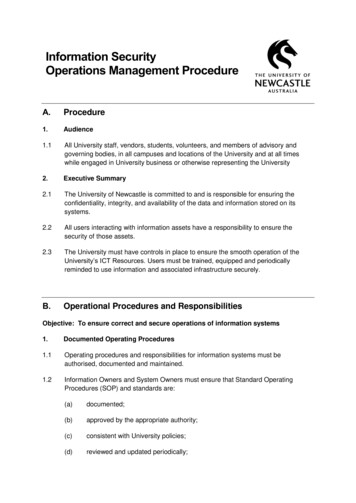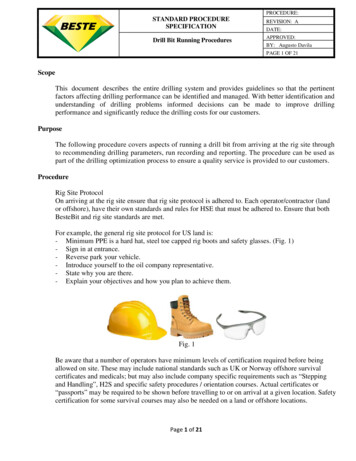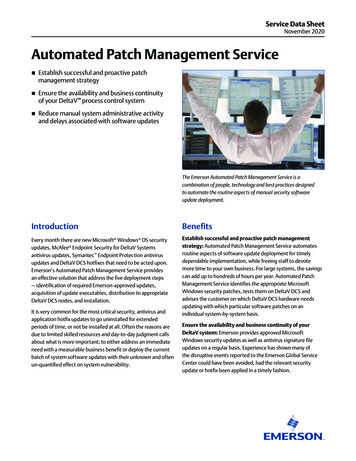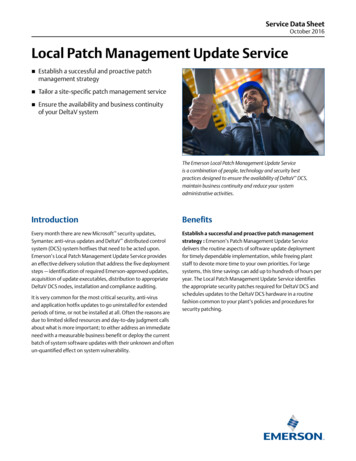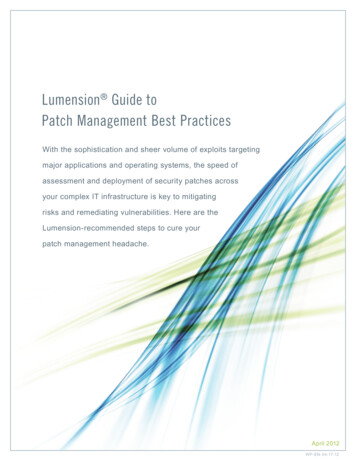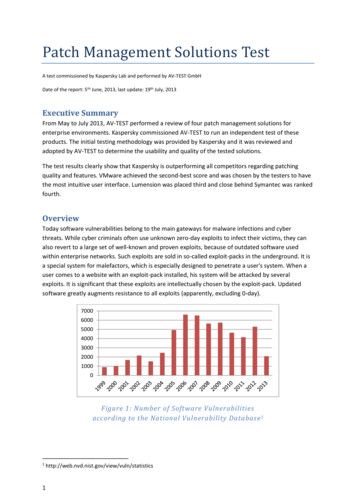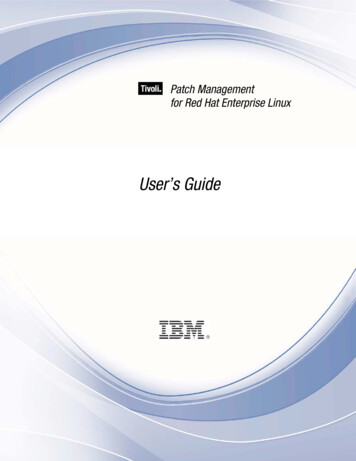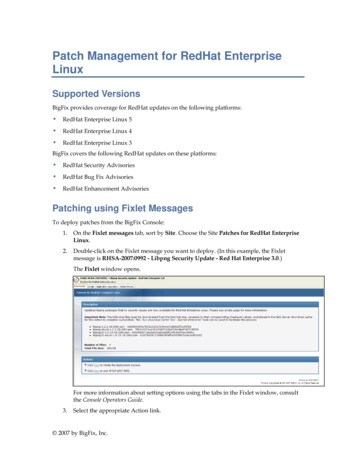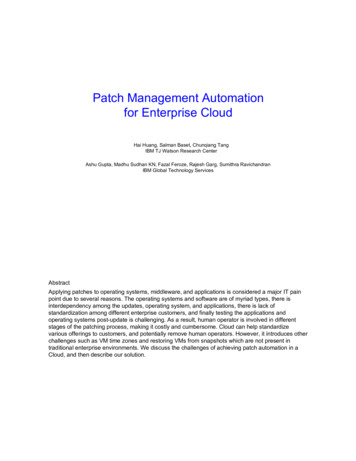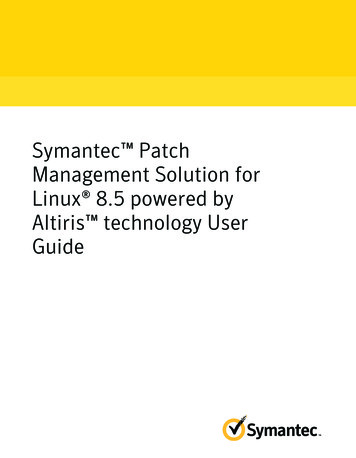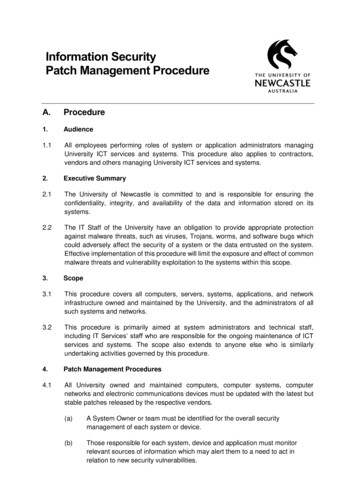
Transcription
Information SecurityPatch Management ProcedureA.Procedure1.Audience1.1All employees performing roles of system or application administrators managingUniversity ICT services and systems. This procedure also applies to contractors,vendors and others managing University ICT services and systems.2.Executive Summary2.1The University of Newcastle is committed to and is responsible for ensuring theconfidentiality, integrity, and availability of the data and information stored on itssystems.2.2The IT Staff of the University have an obligation to provide appropriate protectionagainst malware threats, such as viruses, Trojans, worms, and software bugs whichcould adversely affect the security of a system or the data entrusted on the system.Effective implementation of this procedure will limit the exposure and effect of commonmalware threats and vulnerability exploitation to the systems within this scope.3.Scope3.1This procedure covers all computers, servers, systems, applications, and networkinfrastructure owned and maintained by the University, and the administrators of allsuch systems and networks.3.2This procedure is primarily aimed at system administrators and technical staff,including IT Services’ staff who are responsible for the ongoing maintenance of ICTservices and systems. The scope also extends to anyone else who is similarlyundertaking activities governed by this procedure.4.Patch Management Procedures4.1All University owned and maintained computers, computer systems, computernetworks and electronic communications devices must be updated with the latest butstable patches released by the respective vendors.(a)A System Owner or team must be identified for the overall securitymanagement of each system or device.(b)Those responsible for each system, device and application must monitorrelevant sources of information which may alert them to a need to act inrelation to new security vulnerabilities.
4.2(c)Patches must be obtained from a known, trusted source.(d)The integrity of patches must be verified through such means as comparisonsof cryptographic hashes to ensure the patch obtained is the correct, unalteredpatch.(e)Patches must be tested and assessed before implementation in a productionenvironment to ensure that there is no negative impact as a result.(f)A backup of the production systems must be taken before applying any patch.(g)An audit trail of all changes must be created and documented. The SystemOwner must verify that the patches have been installed successfully afterproduction deployment.(h)Production patches must be deployed regularly as per the SLA defined below.(i)System owners outside of IT Services that manage the security of their ownsystems are required to use patches in accordance with this procedure.(j)A Request for Change (RFC) ticket must be raised for all patch deploymentsincluding emergency updates, critical and operational updates.(k)Refer Information Security Operations Management Procedure for guidelinesto be followed for Change Management ProcessSLA with Priority(a)Patches must be deployed as per below mentioned category classificationand SLAs from the time of the patch being HighMediumLowInternet Facing5 days7 days30 daysNon-Internet Facing7 days30 daysLaptops / Desktops7 days10 daysDeviceTypeNetwork Devices4.3Within 30 daysTargetAcceptableLevel90 days100%95%60 days90 days100%95%60 days90 days100%95%90 days100%95%Category Definitions to be considered for Patch DeploymentRatingCriticalRed Hati,Microsoftii on10A vulnerability whose exploitation could allow code execution orcomplete system compromise without user interaction. Thesescenarios include self-propagating malware or unavoidable commonuse scenarios where code execution occurs without warnings orprompts. This could include browsing to a web page or opening anemail or no action at all.
HighImportant7.0 – 9.9MediumModerate4.0 – 6.9LowLow 4.0A vulnerability whose exploitation could result in compromise of theconfidentiality, integrity, or availability of user data, or of the integrityor availability of processing resources. This includes common usescenarios where a system is compromised with warnings or prompts,regardless their provenance, quality, or usability. Sequences of useractions that do not generate prompts or warnings are also covered.Impact of the vulnerability is mitigated to a significant degree byfactors such as authentication requirements or applicability only tonon-default configurations. The vulnerability is normally difficult toexploit.This classification applies to all other issues that have a securityimpact. These are the types of vulnerabilities that are believed torequire unlikely circumstances to be able to be exploited, or where asuccessful exploit would give minimal consequences.Note: Systems that are locked down within segregated networks may be still be vulnerable to risks asthey are classified above, but the likelihood of exploitation may be reduced. As such, the SLA forpatch deployment is longer as shown in the table above in SLA with priority (3.1).4.4Error handling and Exception Handling(a)Error handling:The System Owner or team is responsible for identifying and rectifying failedpatch deployments. Compliance with approved patches must be verified atleast on a weekly basis(b)Exception Handling:Systems and devices which are not patched via the centrally managedWSUS, SCCM or Satellite services must be updated as per the SLA definedin section 3.1. Where this is not possible exceptions must be obtained fromthe CIO and appropriate compensating controls must be implemented tomitigate the risk. Failure to align with this procedure may result in the affecteddevice or service being removed from the University network.Note: Exceptional cases may be considered including, but not limited to,where the impact of applying a patch (downtime etc.) is higher than theimpact of not applying the patch, e.g. taking down a system running acompute job for a number of months. In such cases appropriatecompensating controls must still be implemented until such time as the patchcan be applied4.5Patch Enforcement(a)4.6Implementation and enforcement of this procedure is the responsibility ofSystem Owners. The IT Security team will conduct random external andinternal vulnerability assessments to ensure compliance with this procedurewithout notice. Any system found in violation of this procedure shall requirecorrective actionMonitoring and Reporting(a)All System Owner and teams responsible for the administration of systemsdefined within the scope above are required to compile and maintain monthlyreporting metrics that summarise the outcome of each patching cycle. These
reports shall be used to evaluate the current patching levels of all systemsand to assess the current level of risk.5.Roles and ResponsibilitiesRoleResponsibilitiesSystem Owner or TeamThe System Owner or team is responsible for the overallsecurity management of each system or device that isassigned to them.IT SecurityResponsible for the following:oooroutinely performing compliance checks with thepatch management procedure;providing guidance to all groups in issues of securityand patch management;ensuring that if something is not secure, it is includedon the ICT agenda driving and documenting the status.6.Definitions6.1See Information Security Definitions document7.Related Documents7.1Polices(a)Information Security Policy(b)Information Security Operations Management Procedure(c)University Risk Management Framework(d)Information Technology Conditions of Use PolicyAbout this DocumentFurther informationTRIM NumberApproval AuthorityChief Information OfficerSubject Matter ExpertPatrick McElhinney – Senior Security Specialist, IT ServicesContact DetailsIt-security@newcastle.edu.auReview Date1st July 2017Approval HistoryNo.Effective DateApproved byV1.031st March 2017CIOAmendment
Red Hat Issue Severity Classification - icationMicrosoft Severity Ratings - 177.aspxiii Adobe Severity Ratings - htmliv CVSS Scoring - https://nvd.nist.gov/cvss.cfmiii
(k) Refer Information Security Operations Management Procedure for guidelines to be followed for Change Management Process 4.2 SLA with Priority (a) Patches must be deployed as per below mentioned category classification and SLAs from the time of the patch being released. Devic
